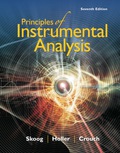
Principles of Instrumental Analysis
7th Edition
ISBN: 9781337468039
Author: Skoog
Publisher: Cengage
expand_more
expand_more
format_list_bulleted
Concept explainers
Question
Chapter 13, Problem 13.6QAP
Interpretation Introduction
Interpretation:
The molar absorptivity of a solution containing
Concept introduction:
The molar absorptivity of a solution is defined as the capacity of a solution to absorb the particular
Now, the relation between the molar absorptivity, absorbance and concentration of the solution is given by the relation.
Expert Solution & Answer
Trending nowThis is a popular solution!

Students have asked these similar questions
First image: I have to explain why the molecule C is never formed in those conditions.
Second image: I have to propose a synthesis for the lactone A
First image: I have to explain why the molecule C is never formed in these conditions
Second image: I have to propose a synthesis for the lactone A
Help fix my arrows please
Chapter 13 Solutions
Principles of Instrumental Analysis
Ch. 13 - Prob. 13.1QAPCh. 13 - Prob. 13.2QAPCh. 13 - Prob. 13.3QAPCh. 13 - Prob. 13.4QAPCh. 13 - Prob. 13.5QAPCh. 13 - Prob. 13.6QAPCh. 13 - Prob. 13.7QAPCh. 13 - At 580 nm, which is the wavelength of its maximum...Ch. 13 - Prob. 13.9QAPCh. 13 - Zinc(II) and the ligand L form a 1:1 complex that...
Ch. 13 - The equilibrium constant for the conjugate...Ch. 13 - The equilibrium constant for the reaction...Ch. 13 - Prob. 13.13QAPCh. 13 - Prob. 13.14QAPCh. 13 - Prob. 13.15QAPCh. 13 - Prob. 13.16QAPCh. 13 - Prob. 13.17QAPCh. 13 - Prob. 13.18QAPCh. 13 - Prob. 13.19QAPCh. 13 - Prob. 13.20QAPCh. 13 - Prob. 13.21QAPCh. 13 - Prob. 13.22QAPCh. 13 - Prob. 13.23QAPCh. 13 - Prob. 13.24QAPCh. 13 - Prob. 13.25QAPCh. 13 - Prob. 13.26QAPCh. 13 - Prob. 13.27QAP
Knowledge Booster
Learn more about
Need a deep-dive on the concept behind this application? Look no further. Learn more about this topic, chemistry and related others by exploring similar questions and additional content below.Similar questions
- Provide the drawing of the unknown structure that corresponds with this data.arrow_forward20.44 The Diels-Alder reaction is not limited to making six-membered rings with only car- bon atoms. Predict the products of the following reactions that produce rings with atoms other than carbon in them. OCCH OCCH H (b) CH C(CH₂)s COOCH མ་ནས་བ (c) N=C H -0.X- (e) H C=N COOCHS + CH2=CHCH₂ →→arrow_forwardGiven the attached data, provide the drawing for the corresponding structure.arrow_forward
arrow_back_ios
SEE MORE QUESTIONS
arrow_forward_ios
Recommended textbooks for you
 Principles of Instrumental AnalysisChemistryISBN:9781305577213Author:Douglas A. Skoog, F. James Holler, Stanley R. CrouchPublisher:Cengage Learning
Principles of Instrumental AnalysisChemistryISBN:9781305577213Author:Douglas A. Skoog, F. James Holler, Stanley R. CrouchPublisher:Cengage Learning Principles of Modern ChemistryChemistryISBN:9781305079113Author:David W. Oxtoby, H. Pat Gillis, Laurie J. ButlerPublisher:Cengage Learning
Principles of Modern ChemistryChemistryISBN:9781305079113Author:David W. Oxtoby, H. Pat Gillis, Laurie J. ButlerPublisher:Cengage Learning Macroscale and Microscale Organic ExperimentsChemistryISBN:9781305577190Author:Kenneth L. Williamson, Katherine M. MastersPublisher:Brooks Cole
Macroscale and Microscale Organic ExperimentsChemistryISBN:9781305577190Author:Kenneth L. Williamson, Katherine M. MastersPublisher:Brooks Cole


Principles of Instrumental Analysis
Chemistry
ISBN:9781305577213
Author:Douglas A. Skoog, F. James Holler, Stanley R. Crouch
Publisher:Cengage Learning

Principles of Modern Chemistry
Chemistry
ISBN:9781305079113
Author:David W. Oxtoby, H. Pat Gillis, Laurie J. Butler
Publisher:Cengage Learning

Macroscale and Microscale Organic Experiments
Chemistry
ISBN:9781305577190
Author:Kenneth L. Williamson, Katherine M. Masters
Publisher:Brooks Cole